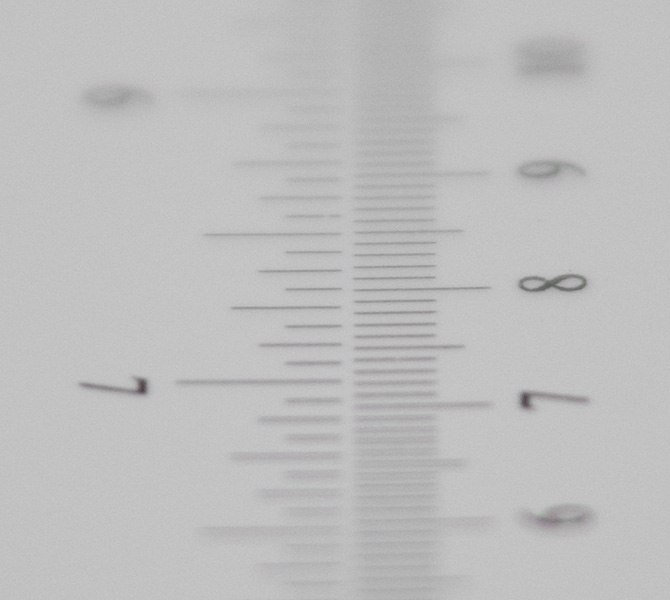|
Sigma 50-100mm f/1.8 DC HSM ART ( Canon ) - Review / Test - Analysis |
|
Lens Reviews -
Canon EOS (APS-C)
|
|
Page 2 of 3

Distortion
The Sigma lens has a decent distortion characteristic. At 50mm it shows a marginal amount of of barrel distortion. At 70mm there is some pincushion distortion (~1.7%) which can be visible in certain scenes (e.g. architecture). At 100mm the pincushion distortion eases again.
Vignetting - APS-C
At fully open aperture, the falloff varies between 1EV and 1.3EV (f-stops). Given the scope of the lens this is good but visible nonetheless. Stopping down to f/2.2 is already sufficient to tame the issue though.

Vignetting - APS-H
Let's start with a clear statement - APS-H is beyond the specs of this lens. Officially the 50-100mm f/1.8 DC HSM ART is an APS-C lens. Some readers still asked us about the vignetting in the bigger APS-H image field. Below are two snapshots taken at 50mm (left) and 100mm (right) taken at f/1.8. The vignetting is about 1.7EV (f-stops) thus, obviously, higher than in the APS-C scope but it's not a major issue.


MTF (resolution)
The resolution characteristic is very good albeit not flawless. Sigma did obviously place a very high emphasis on the image center. The 50-100mm f/1.8 DC HSM ART is almost as good as it gets here (on the EOS 7D II at least). At 50mm and 70mm the center is already superb at f/1.8. At 100mm, the center quality is marginally reduced but catches up at f/2.2 (not shown). The outer image field isn't quite as impressive though. It's generally good at f/1.8 and good to very good mark from f/2.8 to f/8 here.
The centering quality of the tested sample was good. The field curvature is low. If you are considering the Sigma lens for APS-H, you can, of course, take advantage of the immense center quality but the border quality will tank somewhat further in this case.
Please note that the MTF results are not directly comparable across the different systems!
Below is a simplified summary of the formal findings. The chart shows line widths per picture height (LW/PH) which can be taken as a measure for sharpness.
If you want to know more about the MTF50 figures you may check out the corresponding Imatest Explanations
Chromatic Aberrations (CAs)
Lateral CAs can be visible at 50mm with an average CA pixel width of around 1.2px but this is still acceptable. Please note, however, that the issue increases in the far corners (and as such also in the APS-H scope). CAs are a lesser issue in the mid- to upper-range.

Bokeh
From a real life perspective, the resolution may be important but if you are interested in such a lens, you really want to exploit the shallow depth-of-field capabilities. So let's have a look at the bokeh (the rendition of the out-of-focus blur).
Out-of-focus highlights are nicely rendered. Near the image center the highlight discs are circular and the inner zone is pretty smooth. Near the borders/corners you will have to live with cat eyes though.
 The general blur in the focus transition zone is good in the image background (to the left below). The foreground (to the right) is rather rough. You may observe some smearing and hard edges in the right image below (compared to the left image).
The general blur in the focus transition zone is good in the image background (to the left below). The foreground (to the right) is rather rough. You may observe some smearing and hard edges in the right image below (compared to the left image).

Bokeh Fringing
Bokeh fringing is a color fringing effect on the Z-axis. Such axial CAs are extremely difficult to correct and only a handful of lenses are capable of managing this. The Sigma 50-100mm f/1.8 HSM DG ART shows a low amount of axial CAs but you can spot traces at large aperture settings - there are purplish halos in front of the focus point and greenish ones beyond. Stopping down reduces the color fringing but it remains visible till f/2.8.
If you scroll through the aperture range you may also spot that the focus point remains constant - thus the lens doesn't suffer from residual spherical aberrations (focus shifts).
|
Move the mouse cursor over the f-stop marks below to observe the respective LoCAs
|
| f/1.8 |
f/2.2 |
f/2.8 |
f/4 |
|

|
|